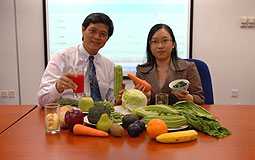
|
Healthy choice: Centre for Food Safety Consultant Dr Ho Yuk-yin meets the press to announce the results of its study on fruit and vegetable nutrients. |
The Centre for Food Safety has enhanced its nutrient information inquiry system, providing nutrition information on 18 parameters of more than 4,300 food items.
A food nutrient calculator has been added to the system to help people make healthy food choices. The average nutrient quantity of food intake can be obtained by selecting the food items and entering the consumption amount into the calculator. Visit the centre's website for details.
Nutrient study
Meanwhile, the centre today released the results of its study on nutrients of fruit and vegetables commonly found in Hong Kong. It covered 82 types of fruit and vegetables, with 49 being sampled from local retail markets.
It found that fruit and vegetables are major sources of dietary fibre and vitamin C, and are free of cholesterol. Their energy values and other nutrients such as sodium and fat contents were low in general.
The centre's consultant Dr Ho Yuk-yin said the energy values in vegetables are low in general, averaging 26 calories per 100g. However, the level of energy content also hinged on cooking methods. Boiling one catty of vegetables with a teaspoon of oil sees a 2g rise in fat content and 18 more calories. Stir-frying vegetables with three tablespoons of oil added 45g of fat and 405 calories.
Salad dressings
Salad vegetables such as lettuce and broccoli are commonly consumed with dressings such as thousand island and Caesar. The study found that the addition of one tablespoon of these dressings could increase the fat content by up to 8g and 44 to 76 calories.
It also found that nearly all the dietary fibre in fruit like oranges, watermelons, mangoes and pears is lost in their juices. According to literature, the amount of dietary fibre in juices is also much less than that in whole fruit.
To achieve a balanced diet, people should consume two servings of fruit and three servings of vegetables daily, Dr Ho said.
"It is advisable to choose a wide variety of fruits and vegetables since they offer different nutrients. For those who want to have more dietary fibre, they may consider eating fruit together with their edible peel after washing them thoroughly."
|